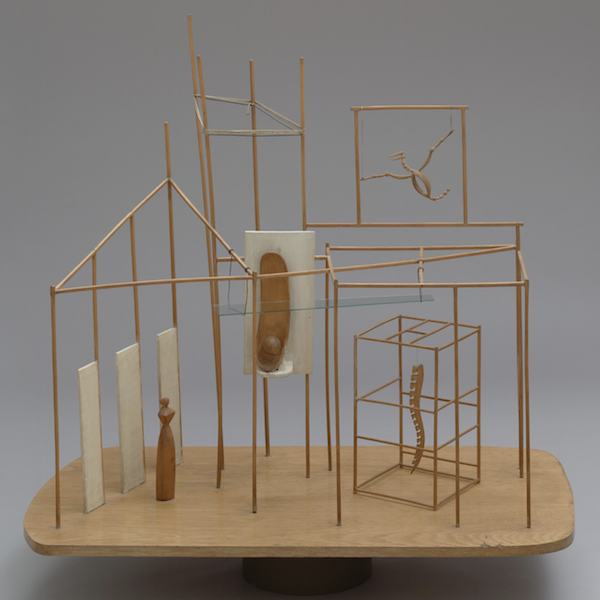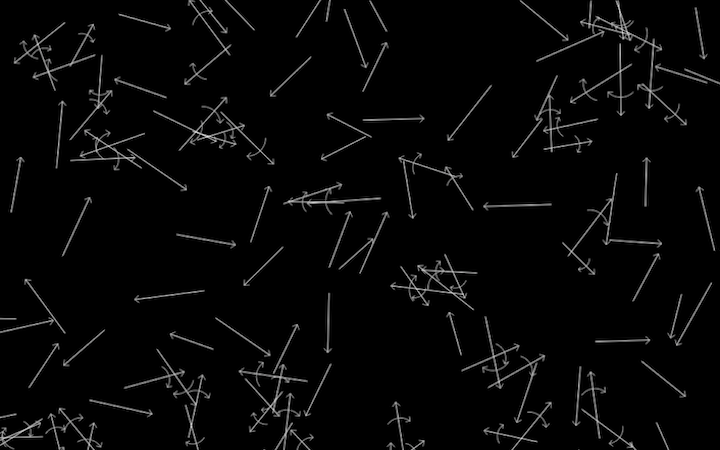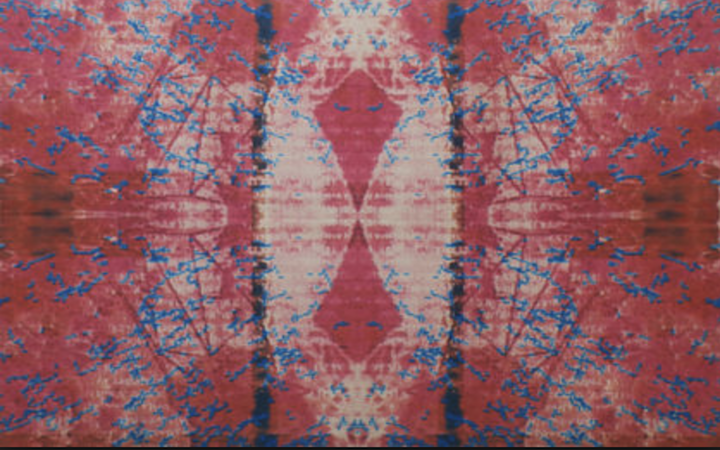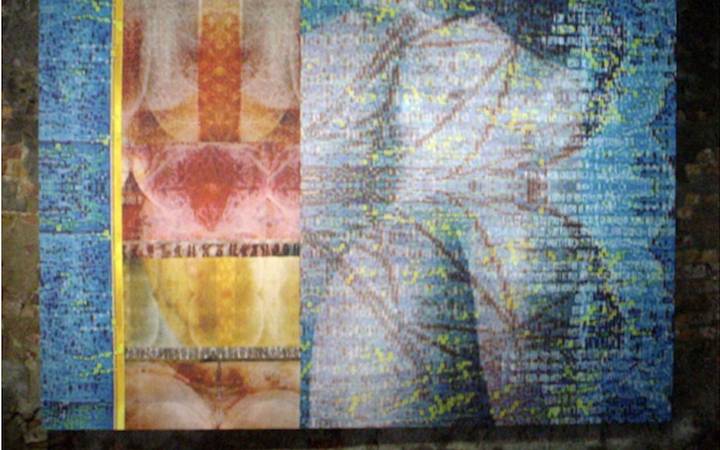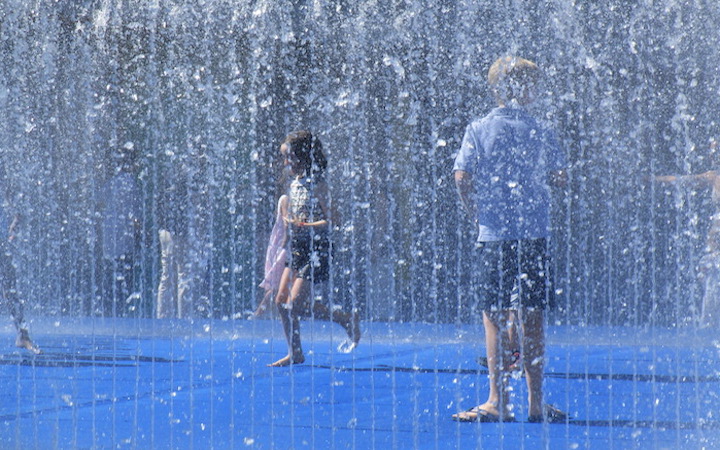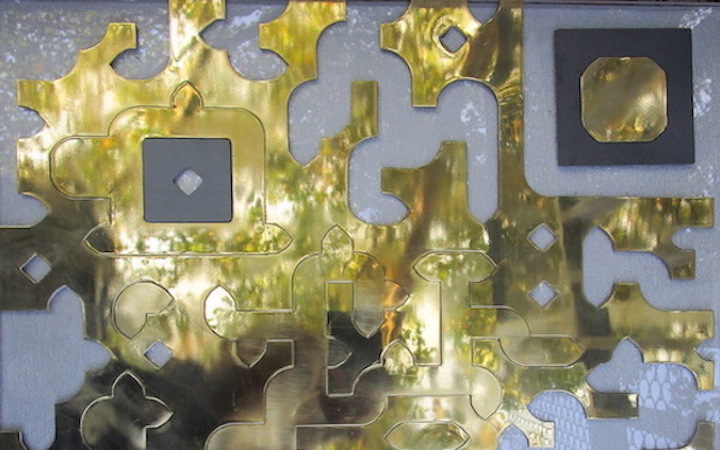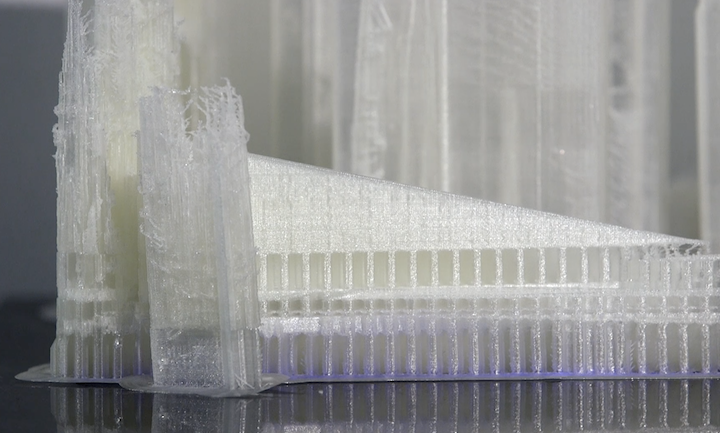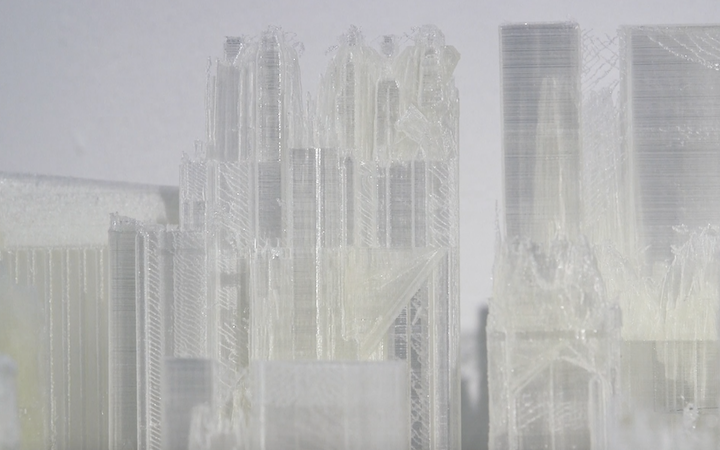The City at 4 am
This installation consists of four works, which metaphorically talk to each other and create a narrative space that explores a meditative interaction between body and mind.
produced by: Geeta Roopnarine
Introduction
Meno: And how will you enquire, Socrates, into that which you do not know? What will you put forth as the subject of enquiry? And if you find what you want, how will you ever know that this is the thing which you did not know? (1)
Rebecca Solnit in 'A Field Guide to Getting Lost', addresses the question of extending the boundaries of the self into unknown territory, into becoming someone else and she suggests that it is the job of the artists to ‘invite in prophesies, the unknown, the unfamiliar’, and in doing so, open a door into ‘that dark sea’ (2). 'The City at 4 am' is the result of research in which as Meno puts it, “how will you enquire into what you do not know.” I knew the general direction where I wanted to go but I was in a state of uncertainty as I was trying to investigate something I could not grasp in real terms. In my work, I am interested in making the inner self visible, in making the connection to the inner self stronger.
The title, 'The City at 4 am', is a nod to Alberto Giacometti’s, 'The Palace at 4 a.m'. Giacometti wrote this prose poem, 'Charbon d’herbe', in the same year that he made the sculpture.
“I return to the constructions that amuse me
and which are alive in their surreality; a beautiful palace…
the shafts of the columns, the ceiling in the air which laughs…
I try gropingly to catch in the void
the invisible white thread of the marvelous
which vibrates, and from which facts and dreams scape… “(3)
This sculpture has always fascinated me, both in its use of space, in the placement of the enigmatic, surrealistic forms and especially the title, which in my imagination, points to a liminal period between night and day, when people wake up to meditate, to write, to tap into the subconscious and find information and insights that are not easily accessible at other times, to… “gropingly to catch in the void
the invisible white thread of the marvelous
which vibrates, and from which facts and dreams scape. “
Concept and Background Research
Concept
'The City at 4 am' uses bio-sensing to playfully suggest that the ‘pulse of the city’ even when it sleeps, is powered by the heart rate variability of its inhabitants. According to the Mayo Clinic, biofeedback technology is used for managing many physical and mental health issues including anxiety or stress, high blood pressure, ADHD and side effects from chemotherapy (4). By observing a sensor-driven display, subjects can learn to sense and influence the signal being measured.
The ‘cityscape’ is computationally created by 3D transformations of visual data using mathematical functions. These range in scale from Hubble images of galaxies to those of single-celled radiolarians and the minute scales of flower petals, realised with SEM photography. A video projection places the inner self as the background, while smaller videos point to the workings of the mind. Images interact with words and computational algorithms to raise questions of complexity and fragmentation of the ‘self’. Prints on paper engage with the transformation of data while forms inspired by QR code raise questions of the encryption and anonymity of data and circle back to the sensor as a means of allowing encrypted data from bodily processes to be transformed into movement of light and colour.
Research
Michel Foucault's writings on ‘Heterotopias’, spaces of otherness, which have multiple meanings, together with Gilles Deleuze and Felix Guattari's ‘rhizomatic thinking’ were guiding forces in my work. Some of the principles that Foucault states are that these spaces can be reflective of the society in which they exist and are linked to slices of time which need permission to enter such as a gesture, ticket or ritual. He offers the boat as an example of heterotopia. It is a floating piece of space, not fixed to any other space except the infinity of the sea (5). In 'One Thousand Plateaus', Deleuze and Guattari suggest that creating a book is like an 'assemblage' (pg. 4). They say that literature is an 'assemblage' and cite William Burroughs’ cut-up method - ‘the folding of one text into another and which constitutes multiple and even adventitious roots (like a cutting) (pg. 6) …’ and implies a cyclic instead of linear unity of the text (6). N. Katherine Hayles in ‘Cognitive Assemblages: Technical Agency and Human Interactions’ (7) discusses the work of Deleuze and Guattari, and states that although ‘assemblage’, carries connotations of connection, transformation and becoming, they might also be thought of as cognitive. She defines cognition as a process of interpreting in contexts that connect with meaning and also expanding the traditional view as human thought to processes occurring at multiple levels and sites within biological life and technical systems. She goes on to say that cognitive 'assemblage' emphasizes ‘cognition’ as the common element among parts and as the functionality by which the parts connect. These readings suggest that the works in 'The City at 4 am' might function as a cognitive 'assemblage' which interacts in the space of the mind, similar to that of Foucault’s boat.
Art influences
Early in the project, I visited the exhibition, 'Counter Investigation: Forensic Architecture' at the Institute of Contemporary Arts in central London. It was instrumental in helping me to understand how to frame a work within the context of research and how to create cohesiveness and depth by focusing on complexity in a clear, uncluttered manner.
George Khut uses biofeedback mechanisms, such as live heartbeat, in art interactions. In his TEDx talk, ‘Can Art Help Medicine’ he quotes David Rokeby, an installation artist, who describes that a technology is interactive to the degree it reflects the consequences of our actions or decisions back to us. Rokeby goes on to say that the medium not only reflects back but also refracts what it is given: what is returned is ourselves transformed and processed. Thus, it is like a mirror (8). This relates to Foucault’s idea of heterotopic space, in that it is like a mirror which acts like a counteraction to the position one occupies. It opens up an unreal virtual space where one can exist, though not in reality. I was also inspired by Casey Reas’s Process Compendium (9) and writings. They are poetic, sparse at first glance, but they grow exponentially and the complexity and connections to things that are seemingly disparate become apparent with each reading. Joseph Nechvatal creates painted works that blur the lines between new and old media. He works between the technological and the biological and uses computer- assisted viruses to deconstruct his painterly images (10). Looking at his work, I feel a common thread in the way he blurs and overlaps images until the meanings become open to multiple interpretations.
Technical
Process
My project went through several stages before the final result. In the beginning, I researched differences in brain structure from a health and well-being perspective. This work was a continuation of my interest in enhancing brain cognition that I had worked on earlier. Some of the research revealed that a person with Alzheimer's disease has a different brain structure than the healthy person, a person in love has a different brain structure from someone who is not in love and also the brain structure of person changes in a matter of weeks if he moves from a city to the countryside.
After investigating biofeedback technology, I was drawn to heart rate changes and began experimenting with a pulse sensor. Initially, I thought of working in form, light and colour. I used Processing and conducted experiments with circles and lines over a background of waves as the sea is also an inspiration in my work.
Pulse Circles:
Pulse Lines:
After working for some time, I realised it was best to have one interaction, be clear about what I wanted to talk about and concentrate on something that had meaning for me as well as other people. I understood that migration and belonging to a place are things that are vital to me and to most people. I was also interested in the architectural inhabited space and I realised that the interactive 'city' would be an exciting way of addressing these themes. Gradually, I began incorporating the various ideas I was working on. The pulse of the city and how people thought and behaved became my central focus and I began to create 3D sculptures in transparent PLA and to assemble an imaginary cityscape which could be used in the biofeedback mechanism.
Visualisations of QR code were also turning over in my mind, much like the noise box in the video collage and I began to connect the idea of encrypted data with the information in our brain and mind. I also began working on the video collage I had begun earlier. A short film I made on a hot day in London with children enjoying sprays of popup water helped me to connect noise, cognition and movement. The film also gave me the inspiration for one of the prints, 'raindance'. I began to investigating other images for a print installation that might support the cityscape sculpture.
In progress:
After spending time in the exhibition space in the church, I saw how the works might resonate together. I began to relate cognition, encrypted data and materials together and worked towards common elements or themes which are reflected in a neighbouring work so they might 'talk' with each other. I used steel, brass, paper, 3D printed sculpture, LEDs and video projection in the same installation and they worked well together as none of the materials was dominant except for the video projection which created a central focal point.
TheCityat4amProcess:
Technical
An Adafruit pulse sensor was used with an Arduino Uno microcontroller to mediate the interaction of the LED Neopixels. The Pulse Sensor is a photoplethysmograph which is a medical device used for non-invasive heart rate monitoring. When the heart pumps blood through the body, a pulse wave travels along all arteries to the finger where the Pulse Sensor is attached. This value is measured by the light from the green LED that is reflected back to sensor. Successive moments of instantaneous heart beat are found and the time between them, called Inter Beat Interval (IBI) is measured. After discarding the first value by using a Boolean function, the next ten values are collected, the average is found and the Beats Per Minute (BPM) is calculated. This is then used to direct the pulsing movement and colour of the LED lights (11)
3D printed sculpture. The code is based on the Artifact Lab algorithm created by Lior Ben Gai. It was extended it using a hypotrochoid and image reader function and converting the hypotrochoid equation to enable parametric rendering of the images (12). After rendering the output in an obj. file format, it was transferred to Cura software, resized and converted for printing. It was then routed to the 3D Ultimaker machine for printing. These works are not designed to illustrate the visual data in reality but to imagine what is possible: the creation of sculptures that lie in a liminal space between being and transforming. The intention is for the sculptures to invite their own meaning apart from its original inspiration.
2D prints. Casey Reas’s transform algorithm was implemented from his book Form and Code (13). The grey value of each pixel was calculated and used to displace the position of a line along the z-axis while slowly rotating. This creates an 3D image which deconstructs while rotating. An image is chosen at an appropriate moment and saved. Most of images were photographic images taken by me in London, two were outputs of the obj file from the Artifact Lab algorithm (a self-portrait and an image of a palm tree bark, photographed at the seaside in Athens).
Video collage. The background image (self-portrait) was created also using the Casey Reas’s transform algorithm. The algorithm projects each word of the speculative fiction (set in the year 2150) by itself on the screen and use a random function to vary the dimension of each word. The random walk algorithm was developed from a class in Processing. It creates small circles, random in size from one pixel to five pixels with a random grey value that also leaves a background trace. The noise box uses code from Matt Pearson’s book, Generative Art (14). X, y, and z points are iterated in the cube together with the noise factor and then rotated. The final video projects four events in black, white and gray with varying movements.
Laser-Cut QR code. An algorithm is implemented from a chapter in the Open Frameworks, 'Of Book' by Michael Hadley (15). A generative mesh is created from the pixels of an uploaded image. Vertices are created when the intensity of the colour is greater than a set value (150pixels) A jitter function is added to give movement and an image saved. A CAD program transforms it to a file suitable for laser cutting.
Future development
I am interested in working in an interdisciplinary context within science and art, researching and working on things that appear to have little connection and then being able to reveal the complexity and multiple meanings by combining different ideas. Working on this project was an intensive learning process and it gave many avenues for future research and development.
1. Investigation and research of other mathematical functions and comparing their effects on images rendered in 3D sculptures. The possibilities of creative 3D printing is vast and still underexplored.
2. Investigation of other generative algorithms with images and creation of 2D prints on paper and possibly aluminium or other surfaces.
3. Investigation of video collages and layering of virtual elements
4. Connection of all the above to cognition and mind-body interaction.
5. Becoming more adept at breaking and restructuring algorithms.
Self evaluation
I am happy with the installation and interaction. Each work has its own area to breathe but also is able to interact metaphorically with the other works. They worked well in the space. I was pleased with the delight on people’s faces as they saw a manifestation of their inner selves on the ‘city’. People liked the idea of images being turned into architectural landscapes and that the city needed their pulse to energise it. They immediately understood the idea and were satisfied with it. They liked the idea of the laser cut QR code as being encrypted and relating back to information flowing through their veins which required a sensor to make that information visible through an interaction of light and motion. People also remarked on the complexity of ideas stemming from the work. Some people spent time looking at the chapbook with my process and some wanted to read more of my writing on the subject. Another person about to set up a startup, was interested in my work as he felt it could be framed in user experiences that companies might be interested in.
I was also delighted to see children interacting with my work.
However, on the last day, just before the show closed, the pulse sensor was ripped off by one overzealous participant. After being disappointed, I decided that I needed to make it work even for an hour. Luckily, I lived nearby and was able to get another pulse sensor, but it highlighted the fact that one needs to have vulnerable components of an installation close by as anything might go wrong. Also, I would have liked if the 3D sculptures were larger, but the size was constrained by the specifications of the 3D printers in the lab. The pulse sensor was extremely glitchy and sometimes it just went off on a tangent, when testing. I created a long black box to prevent light from interfering with it but I had to reset it from time to time during the exhibition using my pulse to bring it down to the lower readings and then it behaved as it should. But it read all the pulse values and reacted to them so that was good. Finally, I feel that I need to spend time investigating some of my interests in depth and most of all understanding why algsorithms work in the way they do. This means understanding some practical applications of mathermatics especially in the field of 3D design.
References
(1) Meno by Plato : http://classics.mit.edu/Plato/meno.html
(2) Solnit Rebecca, A Field Guide to Getting Lost, Cannongate Books, 2006
(3) https://www.moma.org/learn/moma_learning/alberto-giacometti-the-palace-at-4-a-m-1932
(4) https://www.mayoclinic.org/tests-procedures/biofeedback/about/pac-20384664
(5) http://web.mit.edu/allanmc/www/foucault1.pdf
(6) Deleuze Giles and Guattari Felix, A Thousand Plateaus (Minneapolis: University of Minnesota Press, 1987) tr. Brian Massumi
(7) Hayles, N. Katherine, https://www.journals.uchicago.edu/doi/10.1086/688293
(8) Khut George, https://www.youtube.com/watch?v=qFyKqLVOhqE
(9) Reas Casey, http://reas.com/compendium_text/ http://artport.whitney.org/commissions/softwarestructures/map.html
(10) Nechvatal, Joseph, https://creators.vice.com/en_us/article/wnpgwb/artist-paints-with-artificial-life-and-computer-viruses
(11) https://pulsesensor.com/pages/pulse-sensor-amped-arduino-v1dot1
(12) https://en.wikipedia.org/wiki/Hypotrochoid
(13) Reas Casey, McWilliams Chandler, and LUST, Form and Code in Design, Art, and Architecture , Princeton Architectural Press, 2010
(14) Pearson Matt, Generative Art, Manning Publications 2011
(15) Hadley Michael, https://openframeworks.cc/ofBook/chapters/generativemesh.html
https://learn.adafruit.com/adafruit-neopixel-uberguide/best-practices
https://www.instructables.com/id/NeoPixel-LED-Heart-Sensor-Jacket/
https://learn.adafruit.com/pulse-sensor-displayed-with-neopixels?view=all
Shiffman Daniel, Learning Processing, Morgan Kaufmann, 2008
https://www.ica.art/exhibitions/forensic-architecture-counter-investigations
Music excerpt to accompany video taken from : https://www.youtube.com/watch?v=1ZYbU82GVz4
Code Credits:
Code extended from Lior Ben Gai 's Artifact Lab algorithm
Casey Reas, Form and Code: Transform algorithm
Matt Pearson, Generative Art: noise algorithm
Michael Hadley, of Book: Generative Mesh
Arduino Code for Pulse Sensor: https://learn.adafruit.com/pulse-sensor-displayed-with-neopixels/the-code
Neopixel Library for LED lights : https://learn.adafruit.com/adafruit-neopixel-uberguide/arduino-library-use
Also I would like to thank : Prof. Atau Tanaka for opening up a vision of the places I was heading towards but couldn’t yet understand. Dr. Theo Papatheodorou and Lior Ben Gai for demonstrating that code could be bent, broken and reconfigured in new imaginative forms. Dr. Helen Pritchard for expanding my understanding of theoretical frameworks. The technical team, especially Pete, Angus and Nikki for help and support. And Darel di Gregorio for videography clips.
































































